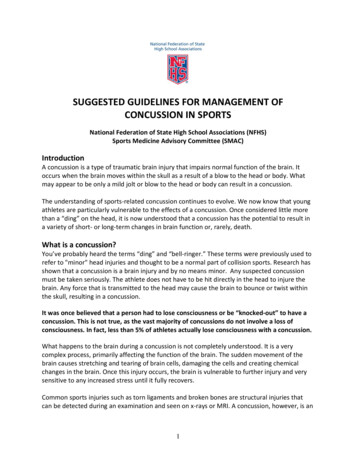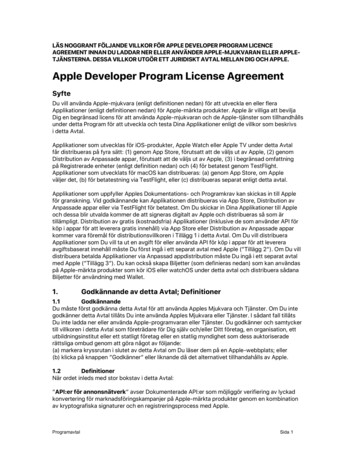
Transcription
SUGGESTED GUIDELINES FOR MANAGEMENT OFCONCUSSION IN SPORTSNational Federation of State High School Associations (NFHS)Sports Medicine Advisory Committee (SMAC)IntroductionA concussion is a type of traumatic brain injury that impairs normal function of the brain. Itoccurs when the brain moves within the skull as a result of a blow to the head or body. Whatmay appear to be only a mild jolt or blow to the head or body can result in a concussion.The understanding of sports-related concussion continues to evolve. We now know that youngathletes are particularly vulnerable to the effects of a concussion. Once considered little morethan a “ding” on the head, it is now understood that a concussion has the potential to result ina variety of short- or long-term changes in brain function or, rarely, death.What is a concussion?You’ve probably heard the terms “ding” and “bell-ringer.” These terms were previously used torefer to "minor" head injuries and thought to be a normal part of collision sports. Research hasshown that a concussion is a brain injury and by no means minor. Any suspected concussionmust be taken seriously. The athlete does not have to be hit directly in the head to injure thebrain. Any force that is transmitted to the head may cause the brain to bounce or twist withinthe skull, resulting in a concussion.It was once believed that a person had to lose consciousness or be “knocked-out” to have aconcussion. This is not true, as the vast majority of concussions do not involve a loss ofconsciousness. In fact, less than 5% of athletes actually lose consciousness with a concussion.What happens to the brain during a concussion is not completely understood. It is a verycomplex process, primarily affecting the function of the brain. The sudden movement of thebrain causes stretching and tearing of brain cells, damaging the cells and creating chemicalchanges in the brain. Once this injury occurs, the brain is vulnerable to further injury and verysensitive to any increased stress until it fully recovers.Common sports injuries such as torn ligaments and broken bones are structural injuries thatcan be detected during an examination and seen on x-rays or MRI. A concussion, however, is an1
injury that interferes with how the brain works and cannot be diagnosed by MRI or CT scans.Therefore, the brain looks normal on these tests, even though it has been injured.Recognition and ManagementIf an athlete exhibits any signs, symptoms or behaviors that make you suspicious of aconcussion, the athlete must be removed from play and closely observed. Sustaining anotherhead injury after a concussion can lead to worsening concussion symptoms, increased risk forfurther injury and, rarely, death.Parents/guardians and coaches are not expected to “diagnose” a concussion. That is the role ofan appropriate health-care professional. However, everyone involved in athletics must beaware of the signs, symptoms and behaviors associated with a concussion. If you suspect thatan athlete may have a concussion, then the athlete must be immediately removed from allphysical activity.Signs Observed by Coaching Staff *Loss of consciousness (even if brief)*Seizure*Increasing sleepiness*Worsening headache*Persistent vomitingDazed or stunned appearanceConfusion about assignment or positionForgetful, for example, doesn’t follow instructionsUncertainty of game, score or opponentClumsy movementsSlow response to questionsMood, behavior or personality changesInability to recall events prior to hit or fallInability to recall events after hit or fall*RED FLAGSSymptoms Reported by Athlete Headaches or “pressure” in headNausea or vomitingBalance problems or dizzinessDouble or blurry visionSensitivity to lightSensitivity to noiseFeeling sluggish, hazy, foggy or groggyConcentration or memory problemsConfusion2
Emotions of “not feeling right” or “feeling down”When in doubt, sit them out!When you suspect that a player has a concussion, follow the “Heads Up” 4-step Action Plan.1. Remove the athlete from play.2. Ensure the athlete is evaluated by an appropriate health-care professional. (RED FLAGS:If any red flag present, the athlete should go to the emergency department)3. Inform the athlete’s parents/guardians about the possible concussion and give theminformation on concussion.4. Keep the athlete out of play the day of the injury, and until an appropriate health-careprofessional says the athlete is symptom-free and gives the okay to return to activity.The signs, symptoms and behaviors associated with a concussion are not always apparentimmediately after a bump, blow or jolt to the head or body and may develop over a few hoursor longer. An athlete should be closely watched following a suspected concussion and shouldnever be left alone.Athletes should never try to “tough out” a concussion. Teammates, parents/guardians andcoaches should never encourage an athlete to “play through” the symptoms of a concussion. Inaddition, there should never be an attribution of bravery or courage to athletes who playdespite having concussion signs and/or symptoms. The risks of such behavior must beemphasized to all members of the team, as well as coaches and parents.If an athlete returns to activity before being fully healed from an initial concussion, the athleteis at greater risk for a repeat concussion. A repeat concussion that occurs before the brain has achance to recover from the first can slow recovery or increase the chance for long-termproblems. In rare cases, a repeat concussion can result in severe swelling and bleeding in thebrain that can be fatal.What to do in an EmergencyAlthough rare, there are some situations where you will need to call 911 and activate theEmergency Medical System (EMS). The following circumstances are medical emergencies:1. Any time an athlete has a loss of consciousness of any duration. While loss ofconsciousness is not required for a concussion to occur, it may indicate more seriousbrain injury.2. If an athlete exhibits any of the following: Seizure Increasing sleepiness Worsening headache Persistent vomiting3
RestThe first step in recovering from a concussion is rest. Rest is essential to help the brain heal.Athletes with a concussion need rest from physical and mental activities that requireconcentration and attention as these activities may worsen symptoms and delay recovery.Exposure to loud noises, bright lights, computers, video games, television and phones (includingtexting) all may worsen the symptoms of concussion. Athletes typically require 24-48 hours ofrest, though some may require longer.Return to LearnFollowing a concussion, many athletes will have difficulty in school. These problems may lastfrom days to weeks and often involve difficulties with short- and long-term memory,concentration and organization. In many cases, it is best to lessen the student’s class load earlyon after the injury. This may include staying home from school during the short period of rest,followed by a lightened schedule for a few days, or longer, if necessary. Decreasing the stress tothe brain in the early phase after a concussion may lessen symptoms and shorten the recoverytime. Additional academic adjustments may include decreasing homework, allowing extra timefor assignments/tests, and taking breaks during class. Such academic adjustments are bestmade in collaboration with teachers, counselors and school nurses.Return to PlayAfter suffering a concussion, no athlete should return to play or practice on that same day.An athlete should never be allowed to resume play following a concussion until symptom freeand given the approval to resume physical activity by an appropriate health-careprofessional.Once an athlete no longer has signs or symptoms of a concussion and is cleared to return toactivity by an appropriate health-care professional, he/she should proceed in a step-wisefashion to allow the brain to re-adjust to exercise. In most cases, the athlete should progress nomore than one step each day, and at times each step may take more than one day. Below is anexample of a return to physical activity program:Progressive Physical Activity Program (ideally under supervision)Step 1: Light aerobic exercise- 5 to 10 minutes on an exercise bike or light jog; no weightlifting, resistance training or any other exercises.Step 2: Moderate aerobic exercise- 15 to 20 minutes of running at moderate intensity inthe gym or on the field without equipment.Step 3: Non-contact training drills in full uniform. May begin weightlifting, resistancetraining and other exercises.Step 4: Full contact practice or training.Step 5: Full game play.4
If symptoms of a concussion recur, or if concussion signs and/or behaviors are observed atany time during the return-to-activity program, the athlete must discontinue all activityimmediately. Depending on previous instructions, the athlete may need to be re-evaluated bythe health-care provider, or may have to return to the previous step of the return-to-activityprogram.Summary of Suggested Concussion Management1. No athlete should return to play (RTP) or practice on the same day of a concussion.2. Any athlete suspected of having a concussion should be evaluated by anappropriate health-care professional.3. Any athlete with a concussion should be medically cleared by an appropriatehealth-care professional prior to resuming participation in any practice orcompetition.4. After medical clearance, RTP should follow a step-wise protocol with provisions fordelayed RTP based upon return of any signs or symptoms.References:American Medical Society for Sports Medicine position statement: concussion in sport. HarmonKG, Drezner J, Gammons M, Guskiewicz K, Halstead M, Herring S, Kutcher J, Pana A, PutukianM, Roberts W; American Medical Society for Sports Medicine.Clin J Sport Med. 2013 Jan;23(1):1-18.McCrory P, Meeuwisse WH, Aubry M, et al. Consensus statement on concussion in sport: the4th International Conference on Concussion in Sport held in Zurich, November 2012 J AthlTrain. 2013 Jul-Aug;48(4):554-75.Returning to Learning Following a Concussion. Halstead M, McAvoy K, Devore C, Carl R, Lee M,Logan K and Council on Sports Medicine and Fitness, and Council on School Health. Pediatrics,October 2013. American Academy of Pediatrics.Additional Resources:Brain 101 – The Concussion ion in Sports- What you need to courseID 15000Heads Up: Concussion in High School Sportshttp://www.cdc.gov/concussion/headsup/high school.htmlNFHS Sports Medicine Handbook, 4th Ed, 2011.5
REAP Concussion Management idelines.htmSport Concussion nt/concussions-101-primer-kids-and-parentsRevised and Approved April 2017October 2013January 2011April 2009October 2008October 2005DISCLAIMER – NFHS Position Statements and GuidelinesThe NFHS regularly distributes position statements and guidelines to promote public awareness of certain health and safety-related issues. Suchinformation is neither exhaustive nor necessarily applicable to all circumstances or individuals, and is no substitute for consultation withappropriate health-care professionals. Statutes, codes or environmental conditions may be relevant. NFHS position statements or guidelinesshould be considered in conjunction with other pertinent materials when taking action or planning care. The NFHS reserves the right to rescindor modify any such document at any time.6
5 If symptoms of a concussion recur, or if concussion signs and/or behaviors are observed at any time during the return-to-activity program, the athlete must discontinue all activity











